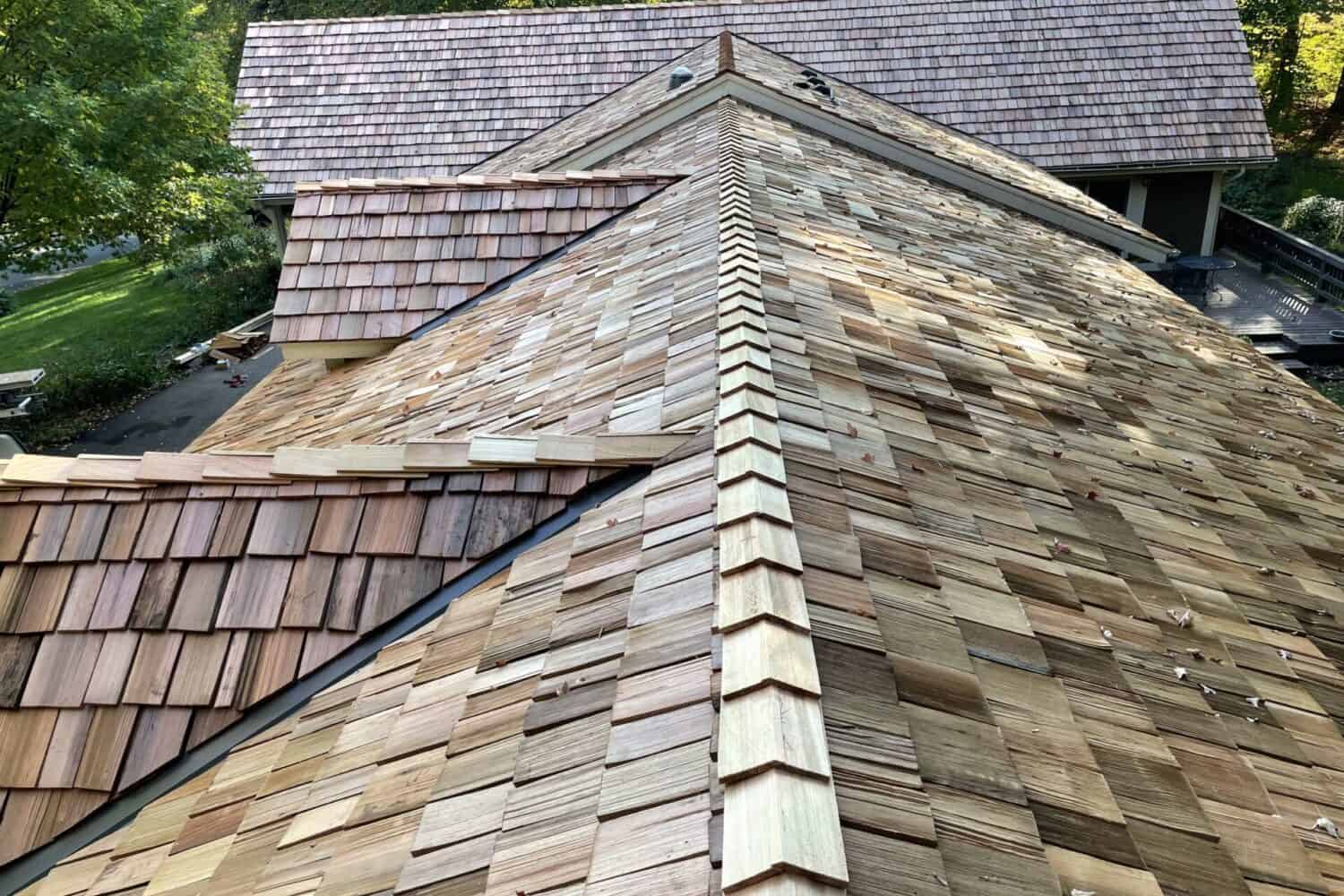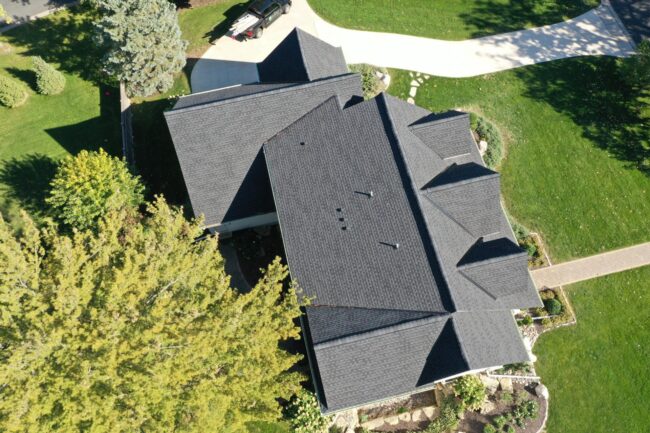A roof serves more than just as a protective shield for your home; it is instrumental in determining the overall energy efficiency of your house. A high-efficiency roof can lower heating and cooling expenses, making your home more comfortable and eco-friendly. In this article, we’ll explore what makes roofs energy efficient, help determine whether they save you money over time, and discuss the best energy-saving and most efficient roof material to choose from. We’ll also consider their cost implications, plus the advantages and disadvantages associated with opting for a specific type of roof.
What makes a roof energy efficient?
An energy-efficient roof aims to reduce heat transfer while maintaining consistent indoor temperatures all year round. An energy-efficient roof achieves this by taking several key factors into account:
Reflectivity: Energy-efficient roofing materials that reflect sunlight – often known as cool roofs – bounce back solar radiation away from your home, reducing how much heat gets absorbed by the roof. This helps keep homes cooler during the summer months, thereby lowering air conditioning usage. The reflective ability varies based on color and surface properties.
Insulation: Proper insulation under the roof is vital for its effectiveness at saving energy since it prevents heat loss during winter or heat gain during summer, allowing stable interior temperature regulation throughout different seasons. Energy-efficient roofing materials like foam or cellulose increase thermal resistance.
Ventilation: Correctly ventilated roofs help control attic temperatures preventing overheating in summers while minimizing moisture accumulation in winters. This helps extend the lifespan of the roofing material and conserves power consumption through soffit vents, for example.
Roof Color/Materials Used: Material type and color affects roof energy efficiency, too. Lighter shades deflect the sun’s rays, whereas darker ones absorb them. However, some exceptions exist where certain substances (like metal) have insulating/reflective qualities thereby impacting performance significantly.
Sustainability Factor: Environmentally-friendly options made from recycled products and renewable resources minimize production and disposal impact, thereby contributing towards greater efficiency levels. Alternatives such as living greenery-covered rooftops are becoming more and more popular and support plant life.
Resistance Against Weather Conditions: Besides being able to withstand harsh weather conditions, an energy-efficient roof may reduce the chances of damage and need for repairs, allowing it to maintain its energy efficiency over time.
Do energy saving roofs save you money?
Yes, energy savings roofs can indeed result in long-term savings. While the initial cost might be slightly higher than conventional options, as a homeowner, you’ll recoup your investment through lower energy bills and potentially fewer maintenance costs.
How Can an Energy Efficient Roof Save You Money?
There are a number of ways an energy efficient roof can save you money. Here are just a few:
Lower Utility Bills: Properly insulated and reflective rooftops significantly cut down on heating or cooling needs, thereby lowering utility expenses. In warmer climates where air conditioning usage is high, a reflective roof helps keep interiors cooler, while during the colder months this insulation prevents heat loss.
Longer Roof Life: Such materials are often more durable, resisting the effects of weather better. This means the roof lasts much longer, reducing repair and replacement frequency, which at the end of the day helps save you money.
Environmentally Friendly: Lowering energy consumption reduces your carbon footprint, thereby contributing towards a sustainable future. By installing an energy efficient roof you are lessening the negative environmental impacts associated with energy production.
Potential Financial Benefits: Certain regions provide incentives or tax credits and rebates for installing an energy efficient roof, which helps offset their upfront costs making them even more economical.
What are the best energy saving materials for roofs?
The most efficient roof type depends upon factors like climate conditions, budget preferences, and more, but here are some common choices to consider when looking for energy saving materials for roofs:
Metal Roofs: Known for their reflectivity and durability, metal roofs constructed of steel, copper, and aluminum last decades. They work by reflecting sunlight, thereby cutting down on overall energy consumption levels. In addition, when installing metal roofs, they can have excellent solar reflectance and emittance properties, making them a popular choice among homeowners looking to improve their home’s energy performance.
Cool Roofs: Designed specifically to maximize solar reflectance and emittance, these usually light-colored materials include white membrane tops, cool asphalt shingles, or special coatings applied onto existing surfaces. Cool roofs effectively deflect the sun’s rays and minimize heat absorption.
Slate and Tile Tops: Natural stone and clay tiles insulate well, maintaining stable indoor temperatures. This is particularly suitable in hot, summer-prone areas due to their inherent thermal resistance qualities.
Greenery Covered Surfaces: Green/living roofs are covered with plant life and offer natural insulation and cooling, thereby reducing heat gain and improving energy performance. They not only help reduce energy consumption, but also promote urban biodiversity.
Roof Coatings: Reflective coatings applied onto existing surfaces enhance solar reflection minimizing absorption.
Composite Shingles: Some composite energy efficient shingles made from recycled rubber or plastic offer durability plus efficiency. They mimic the appearance of traditional materials while providing energy-saving advantages.
The most suitable energy saving roof material for your home would depend on individual circumstances, such as local weather conditions, your budget, aesthetic preferences, and more. Therefore, consulting a professional roofer can help you make the right decision among all the energy efficient roofing options available.
Do Energy-Efficient Roofs Cost More?
While high-efficiency roofing options might have higher upfront costs compared to conventional alternatives, it’s important to consider their long-term savings and benefits when evaluating their overall cost-effectiveness. Though initial investment may be more, these benefits should offset that:
Energy Savings: Lower utility bills over time could potentially save money, especially in areas with an extreme climate.
Extended Lifespan: Energy-efficient materials tend to last longer and need less maintenance, thereby saving on replacement and repair expenses.
Potential Incentives: Certain regions provide incentives, tax credits, or rebates for installing energy efficient roofs. This helps offset upfront costs making them even more economical.
Environmental Impact: By lowering your power usage and making a positive environmental impact, you are contributing towards a sustainable future.
Increased Property Value: A highly efficient roof enhances property value. Potential buyers might pay a premium price for properties with an energy efficient roof, justifying the investment further.
Pros & Cons of High Efficiency Rooftops
To assist you in making an informed decision on whether a highly efficient rooftop is right for your home, let’s look at some of the pros and cons :
Pros
Energy Savings: Reduced heating and cooling costs translates into financial gains over time.
Environmentally Friendly: A lower carbon footprint aligns with increasing focus on green building practices.
Durability: Energy efficient roofs are generally more durable and last longer, leading to lower repair and replacement expenses over their lifespan.
Comfort Factor: An energy efficient roof helps maintain consistent indoor temperature levels which can enhance comfort levels. Fewer fluctuations in temperature translates to a pleasant living environment overall.
Financial Perks: Certain regions offer financial perks for choosing energy efficient roof options. These financial perks can help offset a homeowner’s initial cost, making this investment more appealing.
Increased Property Value: A high-efficiency rooftop increases property value and provides a return on investment when selling the home.
Cons
Higher Initial Cost: Upfront costs on energy efficient roofs are higher than traditional roofs.
Limited Availability: Not all roofing materials may be available everywhere, nor do they fit every budget.
Maintenance Requirements: Some energy efficient roofs, such as green roofs, require regular upkeep which could add to ongoing expenses.
Installation Intricacy: Certain energy-saving roofing systems could necessitate expert installation, possibly escalating the total expense. It is important to seek advice from an experienced roofer who has experience with these types of materials.
Restricted Design Choices: Despite increasing diversity in green roofing options, some energy efficient roof choices might have limited style and color variations relative to traditional ones. However, this range continues its steady expansion.
Climate Factors: The performance of specific materials can fluctuate based on regional weather conditions. Therefore choosing suitable sustainable roof material according to your area’s climate patterns is vital.
Preservation and Upkeep: Although environmentally friendly roofs generally require less maintenance than others, their long-term care should be factored into consideration for continued optimum functionality.
Conclusion
Investing in an energy-efficient roof serves as a prudent choice that enhances your home’s energy efficiency while diminishing environmental impact and saving you money in the long run. Even though there might be heftier starting costs involved, lasting benefits such as reduced utility bills over time and prolonged lifespan of the roof itself alongside increased property value make them worth considering seriously.
When picking out an energy efficient roof material, you must consider your local climate conditions, budget constraints, your aesthetic preferences, and other variables before arriving at your decision. Consulting a professional well-versed in different kinds of roofing will assist you in making the best possible decision tailored specifically towards optimizing your home energy conservation needs while experiencing the enhanced living comfort they offer.
Choosing a green roof not only makes sound financial sense but also reflects responsible ecological stewardship. This type of investment ensures future-proofing of homes by providing comfortable living environments, significant savings potential, and numerous environment-friendly perks. As we move forward prioritizing sustainability coupled with the sound use of resources, investing in an energy efficient roof soon becomes an integral part of our journey towards a more conscientious greener tomorrow.


